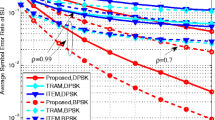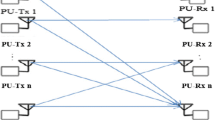Abstract
In this paper, we consider a spectrum sharing cognitive radio network coexisting with a primary network. Particularly, the channel state information (CSI) between the secondary transmitter and the primary receiver is assumed to be outdated due to channel feedback latency. The secondary user (SU) is assumed to satisfy a given delay quality-of-service (QoS) constraint as well as the average interference power constraint. We aim to derive the maximum arrival rate of the SU under aforementioned constraints with the outdated CSI. In this respect, we derive the optimal power allocation to achieve the maximum effective capacity, and further derive the effective capacity. The closed-form expressions for the lower and upper bounds on the effective capacity are also derived. In addition, we obtain the effective capacities under two widely adopted adaptive transmission schemes, i.e., optimal power and rate allocation (OPRA) and truncated channel inversion with fixed rate (TIFR). Numerical results are conducted to corroborate our studies. It is shown that the effective capacities of the SU under various transmission schemes are insensitive to the channel correlation coefficient especially under low channel correlation coefficient. It is also shown that the lower and upper bounds on the effective capacity are significantly tight under stringent delay QoS constraint.
Similar content being viewed by others
References
Federal Communications Commission. Spectrum policy task force report. ET Docket No. 02-155, 2002
Haykin S. Cognitive radio: brain-empowered wireless communications. IEEE J Sel Areas Commun, 2005, 23: 201–220
Haykin S, Thomson D, Reed J. Spectrum sensing for cognitive radio. Proc IEEE, 2009, 97: 849–877
Wu D, Negi R. Effective capacity: a wireless link model for support of quality of service. IEEE Trans Wirel Commun, 2003, 2: 630–643
Musavian L, Aissa S. Quality-of-service based power allocation in spectrum-sharing channels. In: Proceedings of IEEE Global Telecommunications Conference, New Orleans, 2008. 1–5
Musavian L, Aissa S. Effective capacity of delay-constrained cognitive radio in nakagami fading channels. IEEE Trans Wirel Commun, 2010, 9: 1054–1062
Xu D, Feng Z Y, Zhang P. Protecting primary users in cognitive radio networks with effective capacity loss constraint. IEICE Trans Commun, 2012, 95: 349–353
Akin S, Gursoy M. Effective capacity analysis of cognitive radio channels for quality of service provisioning. IEEE Trans Wirel Commun, 2010, 9: 3354–3364
Akin S, Gursoy M. Cognitive radio transmission under interference limitations and QoS constraints. In: Proceedings of IEEE International Conference on Communications, Dresden, 2010. 1–5
Peha J. Approaches to spectrum sharing. IEEE Commun Mag, 2005, 43: 10–12
Kang X, Garg H, Liang Y C, et al. Optimal power allocation for OFDM-based cognitive radio with new primary transmission protection criteria. IEEE Trans Wirel Commun, 2010, 9: 2066–2075
Suraweera H A, Smith P J, Shafi M. Capacity limits and performance analysis of cognitive radio with imperfect channel knowledge. IEEE Trans Veh Technol, 2010, 59: 1811–1822
Kim H, Wang H, Lim S, et al. On the impact of outdated channel information on the capacity of secondary user in spectrum sharing environments. IEEE Trans Wirel Commun, 2012, 11: 284–295
Clarke R. A statistical theory of mobile-radio reception. Bell Syst Tech J, 1968, 47: 957–1000
Zhu H L, Wang J Z. Chunk-based resource allocation in OFDMA systems—part I: chunk allocation. IEEE Trans Commun, 2009, 57: 2734–2744
Zhu H L, Wang J Z. Chunk-based resource allocation in OFDMA systems—part II: joint chunk, power and bit allocation. IEEE Trans Commun, 2012, 60: 499–509
Zhang R. On peak versus average interference power constraints for protecting primary users in cognitive radio networks. IEEE Trans Wirel Commun, 2009, 8: 2112–2120
Xu D, Feng Z Y, Zhang P. Minimum average BER power allocation for fading channels in cognitive radio networks. In: Proceedings of IEEE Wireless Communications and Networking Conference, Cancun, 2011. 78–83
Gradshteyn I, Ryzhik I. Table of integrals, series, and products. 7th ed. San Diego: Academic Press, 2007
Goldsmith A, Varaiya P. Capacity of fading channels with channel side information. IEEE Trans Inf Theory, 1997, 43: 1986–1992
Author information
Authors and Affiliations
Corresponding author
Rights and permissions
About this article
Cite this article
Xu, D., Feng, Z. & Zhang, P. Effective capacity of delay quality-of-service constrained spectrum sharing cognitive radio with outdated channel feedback. Sci. China Inf. Sci. 56, 1–13 (2013). https://doi.org/10.1007/s11432-013-4805-x
Received:
Accepted:
Published:
Issue Date:
DOI: https://doi.org/10.1007/s11432-013-4805-x




